- Last year, back-to-school (B2S) spending in the U.S. was projected to hit $83.6B — making it second only to Black Friday Cyber Monday
- In the lead up to B2S 2018 (May-June), Dormify has already increased revenue by 99% and conversions by 64% YoY
- Using Launchpad, the company has automated 100+ sales events; expects to 2X annual revenue as it becomes a truly omni-channel brand
- Another of their automation strategies — a ‘Your Price’ Script used with Launchpad — lifted conversions 70% during a recent holiday
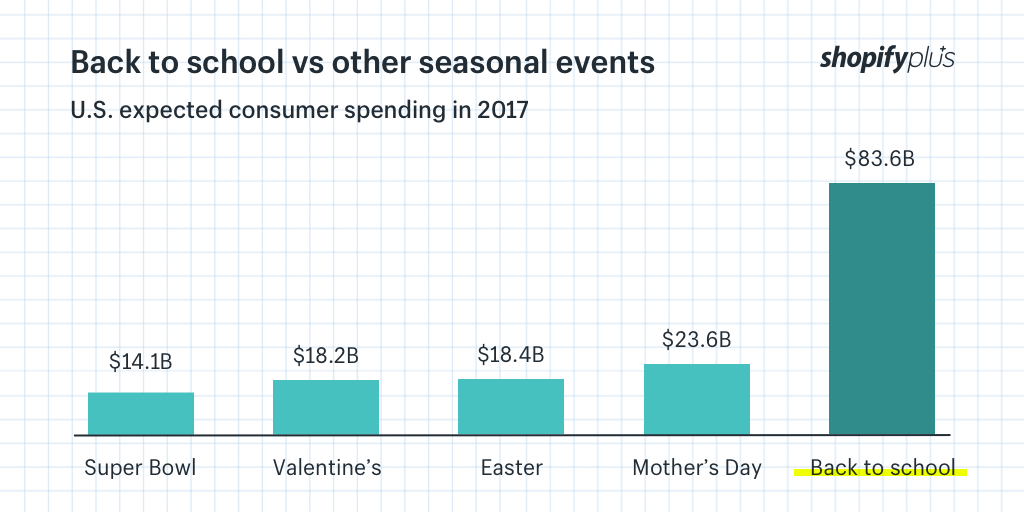
From researching how your target audiences shop to deciding which products to promote on which ecommerce marketplace to launching last-minute changes to your ecommerce themes, pricing, and products …
Your business’ effort is best spent optimizing back-to-school marketing and sales, not managing your online store.
To help you do that, we’ve broken this B2S guide into three parts:
- Cheat Sheets: B2S Marketing Stats, Trends & Data
- No More All-Nighters: Ecommerce Automation ⬅️ (Skip Ahead)
- Extra Credit: Automating Checkouts and Workflows
Even better, we’ve partnered with one of the fastest-growing companies in the B2S space, Dormify, to show you exactly how they’re automating their B2S marketing to save time and maximize conversions.
Ready to put your B2S events on autopilot?
Keep reading to discover the trends and data shaping back-to-school online shopping this year. But, if you’re already a Shopify merchant and you want to skip ahead …
1. Cheat Sheets: B2S Marketing Stats, Trends & Data
When to start back to school marketing?
The back-to-school shopping season runs from July 12 to September 8th, with heavy online shopping starting a little later.

Your digital marketing campaigns are therefore best targeted to desktop shoppers during the week and mobile shoppers on the weekends in August through to early September – while they look for last-minute deals online and in-store.
A 2018 survey from RetailMeNot and Kelton Global Research revealed that “the majority of retailers (89%) believe there is more competition for the attention of back-to-school shoppers than ever before.” So, you’ll also need to do some extra credit work to attract and keep new customers.
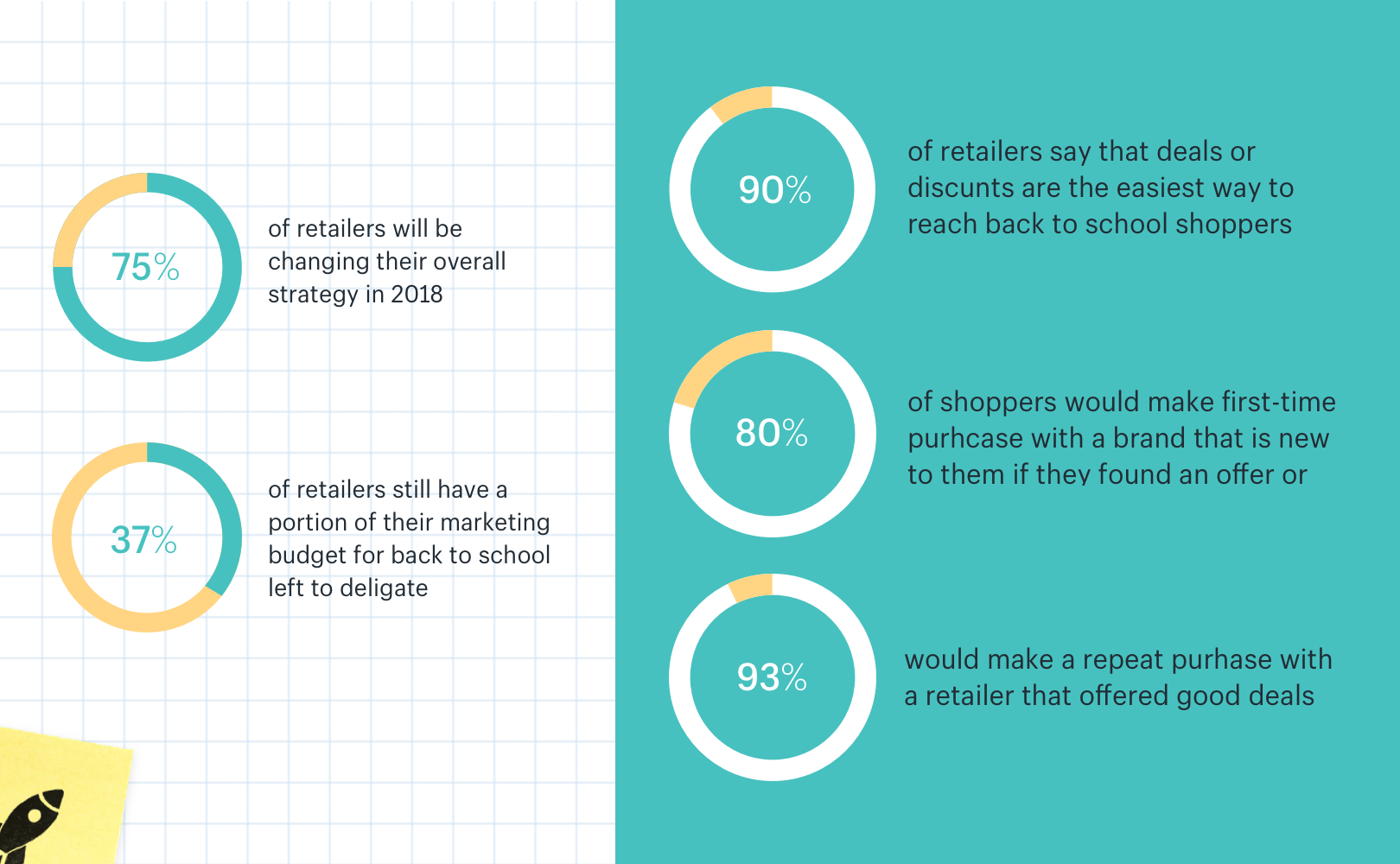
RetailMeNot predicts that in-store offers will receive 3X higher engagement than online-only offers, so it’s essential to determine how you’ll target those mobile shoppers to convince them to buy with you versus a competitor.
You must also consider how to compete with Amazon during Prime Day, which is expanding to a day and a half this year, starting on July 16th. If past consumer B2S online shopping habits are any indication, Prime Day is going to be everyone’s biggest competitor early in the summer.
Customers will also be comparison shopping on July 16th, looking to see if Amazon really has the best deals, which isn’t always the case. We’ll get into some Amazon promotional and competitive strategies shortly.
Now is the time to optimize your ecommerce site to maximize mobile conversions.
It’s true that the retail industry saw desktop account for 44% of all online traffic but still commanded 61% of 2017 holiday sales, according to Adobe Digital Insights. However, Shopify merchants saw mobile account for 64% of all sales, an increase of 10% year-over-year during Black Friday Cyber Monday 2017:
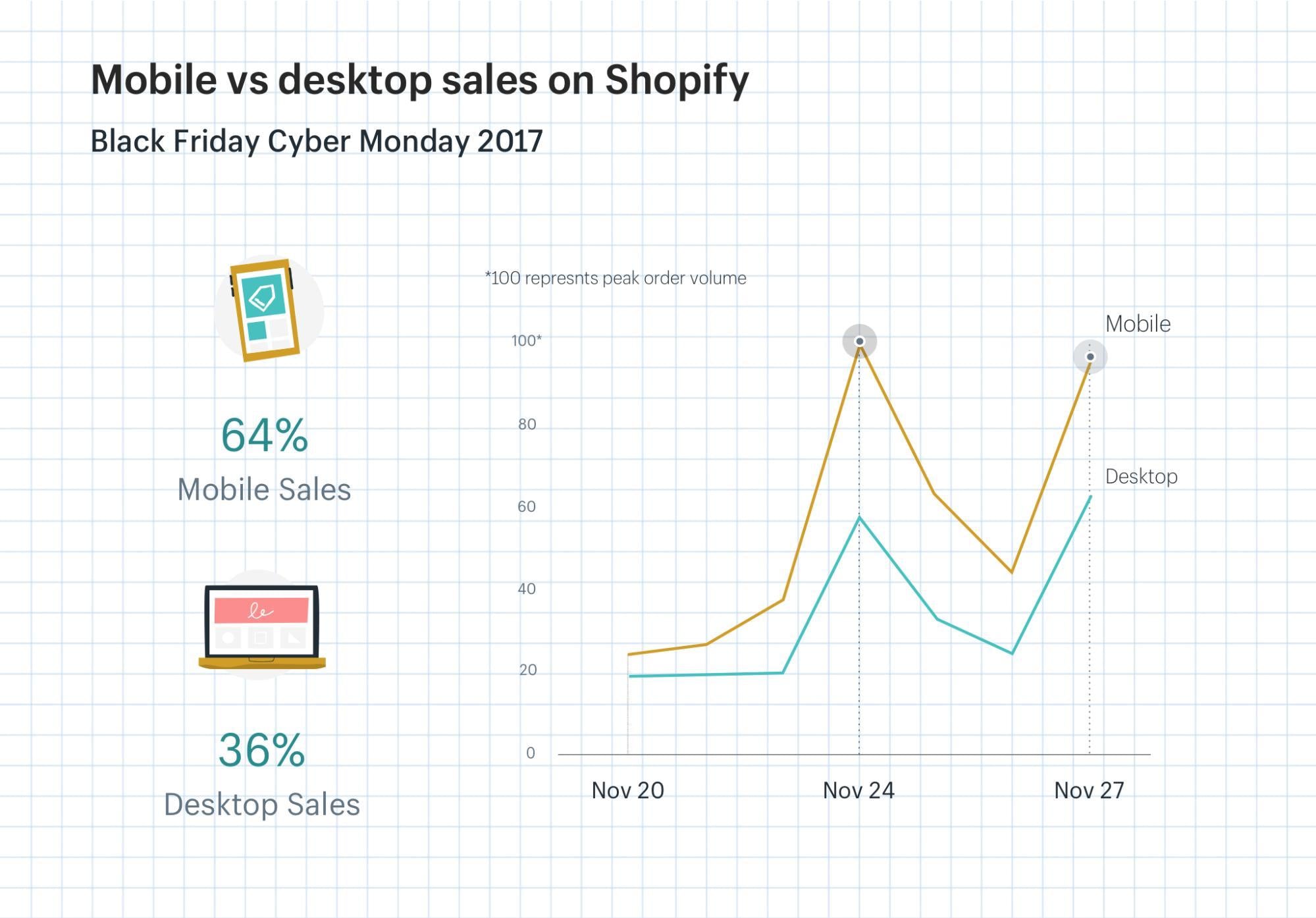
That trend is likely to continue into the 2018 B2S online shopping season and beyond.
Last year, a survey by Rubicon Project found “that mobile would be used heavily amongst parents, with 60% of parents planning to use mobile devices for their start-of-year shopping and 30% planning to do at least a quarter of their Back-to-School shopping on mobile.”
For tips and best practices to optimize your ecommerce store UX for maximum mobile conversions, read: The Future of Mobile Commerce: 10 Trends, 37+ Stats & Three Case Studies.
U.S. B2S Shopping
In 2017, planned B2S spending was $83.6 billion USD. Primary and high school markets made up $29.5 billion of that, with an average household spend of $688:
- Apparel: $239
- Electronics: $204
- Shoes: $130
- School supplies: $114
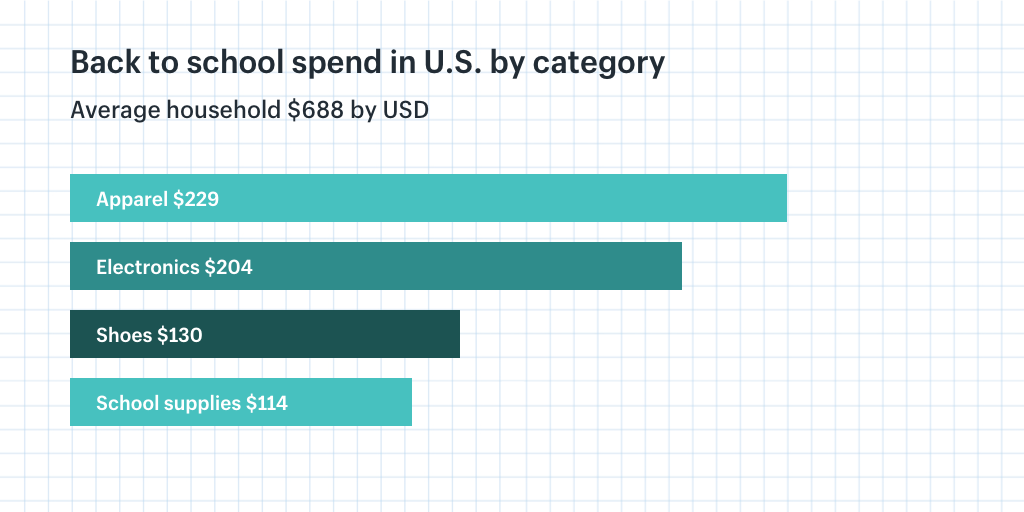
Back to college made up $54.1 billion with an average household spend of $970:
- Electronics: $229
- Clothing: $143
- Food: $134
- Furnishings: $106
- Shoes: $81
- Personal care: $81
- School supplies: $70
- Other: $126
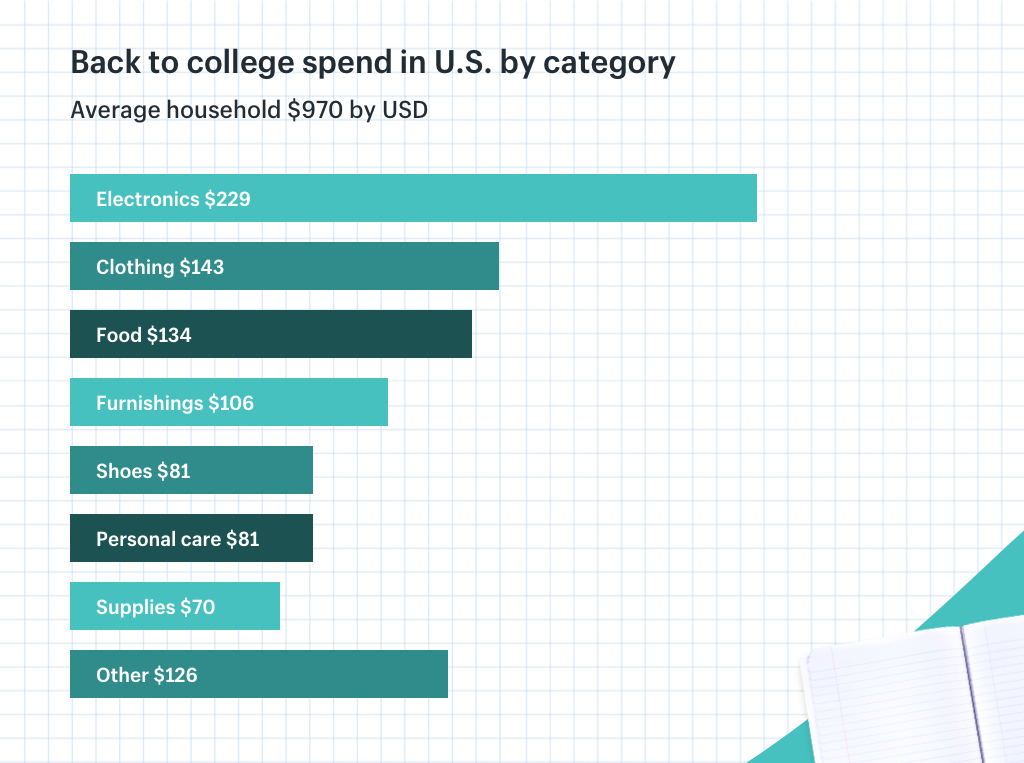
Canada B2S Shopping
Last year, Canadian households planned to spend an average of $883 CAD, nearly twice the $450 spent in 2016. Parents expected to pay more than double what students spend: parents $480 vs. $208 students.
Interestingly, male parents spent $110 more on average than female parents and are 16% more likely to shop online than moms.
Statista’s aggregated data breaks the parental spending down into three demographics:
- University students: $1630
- High school students: $412
- Elementary students: $318
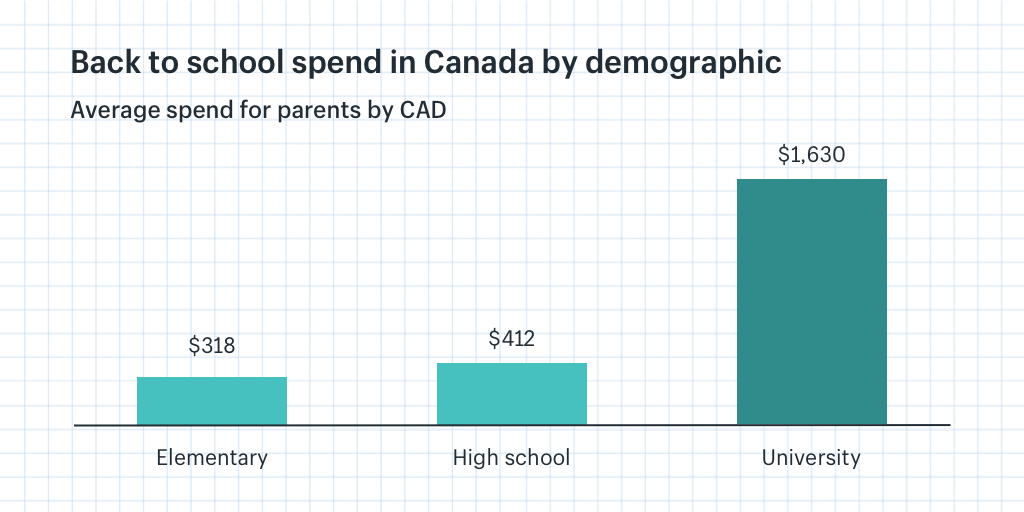
Looking at ecommerce B2S spending in particular — excluding textbooks — that same dossier identifies five product categories as the most lucrative:
- Clothes: $187
- Supplies: $95
- Shoes: $92
- Beauty: $60
- Backpacks: $47
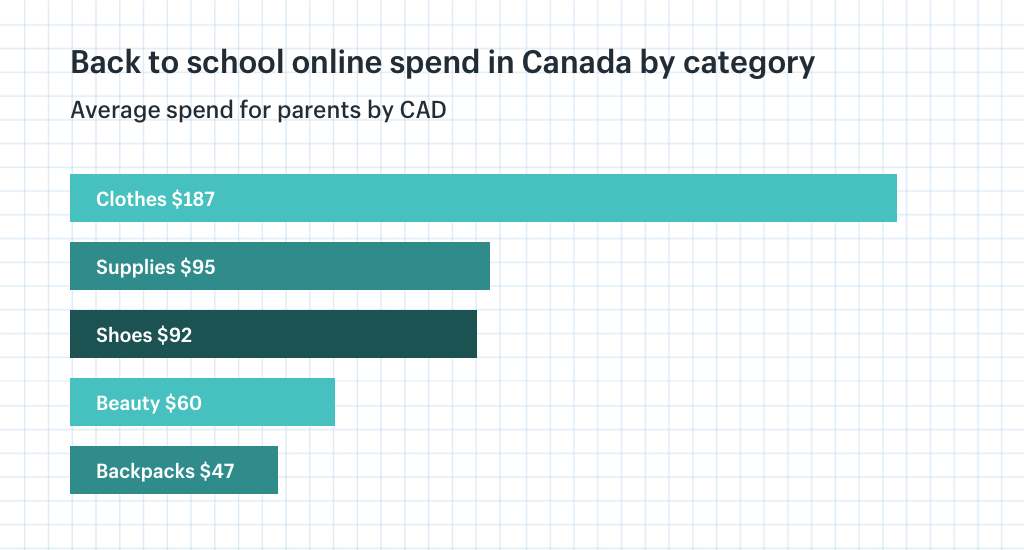
U.K. B2S Shopping
Parents in the U.K. spent £1.48 billion on back-to-school retail items in 2017, down from £1.56 in 2016. The average back to school spend per U.K. adult in 2017 was £174.31.
Top retail categories for parents with children between 4 and 16 years old included:
- Uniforms (clothing) £33
- Shoes £27
- Sports equipment and kits £25
- Jackets and coats £23
- Sports shoes £20
- Technology £8
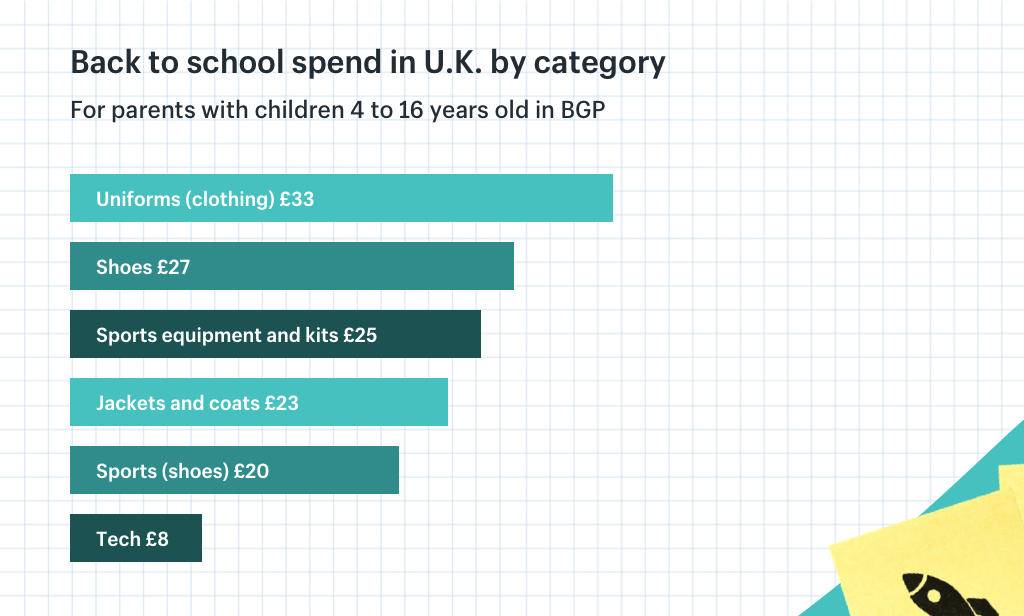
Where & How Back-to-School Shoppers Shop
Shoppers plan to buy via a variety of channels, with parents of primary and high school students choosing offline channels first, and back to college shoppers starting online.

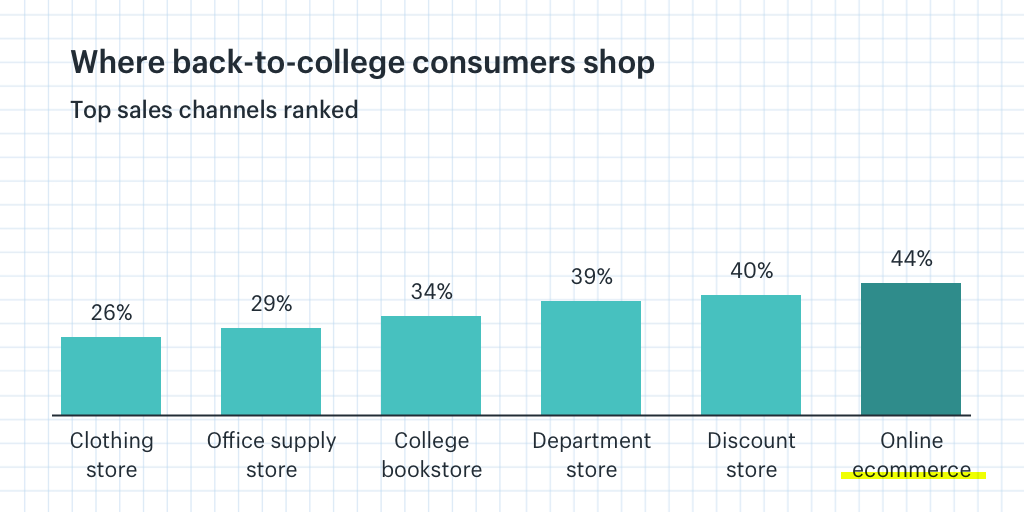
Likewise, a Deloitte survey revealed that while offline channels still dominate across demographics, high B2S spenders are more like to opt for online channels when purchasing big ticket items like computers and electronic gadgets.
The overall preference for in-store retail doesn’t mean that other categories and online channels cannot capitalize on this seasonal shopping frenzy. The Deloitte survey also found that 22% of shoppers are unsure where they will shop:
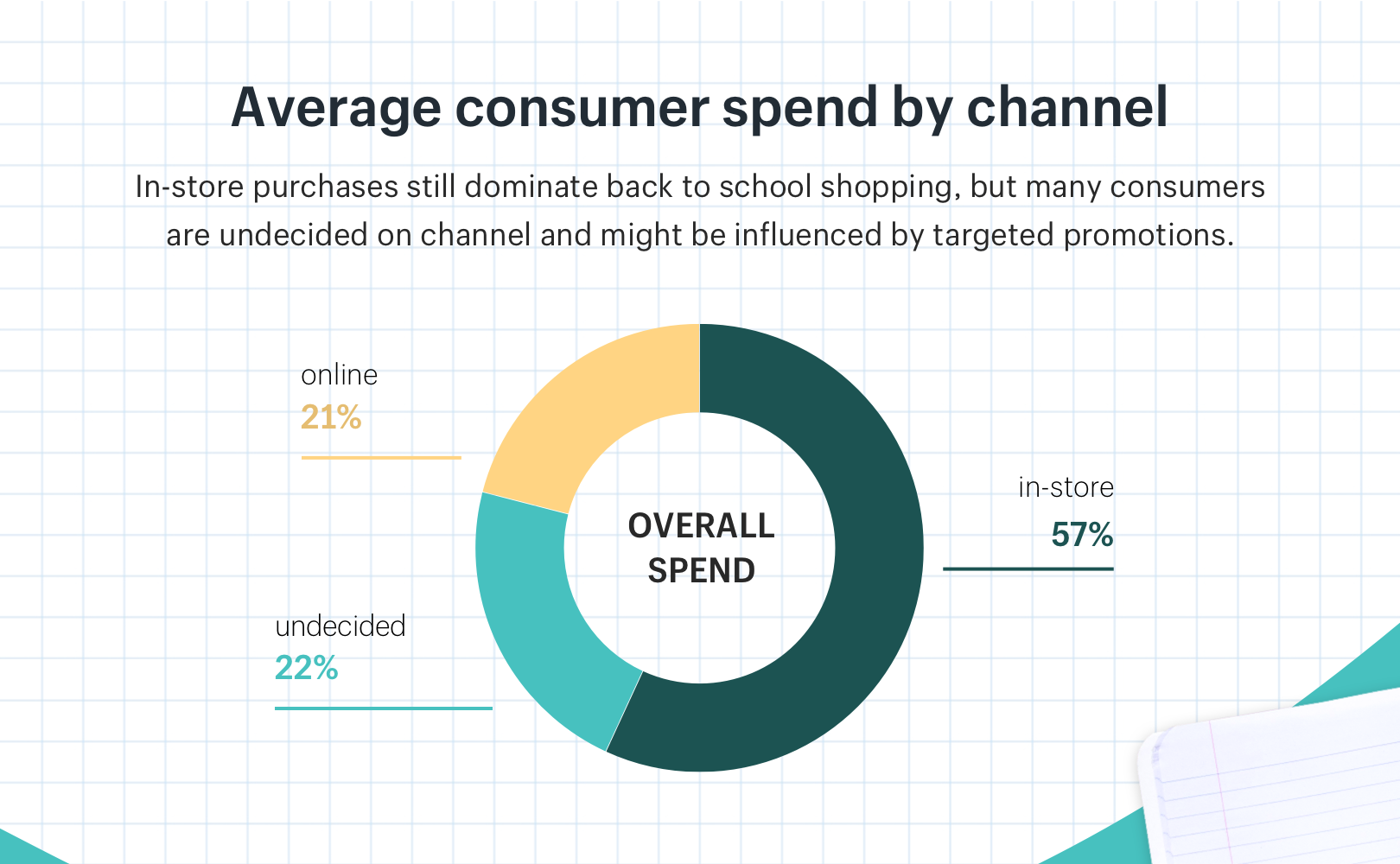
According to Deloitte:
“Retailers should aggressively pursue the ‘undecided’ consumer because they collectively represent nearly $5.4 billion this back-to-school shopping season."
“This segment is up for grabs but likely to go to retailers that draw customers in early with promotions and digital experiences that make store visits even more attractive, like inventory visibility or buy online/pick up in-store.”
In addition, an eBates poll found that 67% of Canadians planned on doing of some of their back-to-school shopping online. If you target the right customer, with the right promotion online, you can steal yourself a piece of that undecided budget pie, even if your site or retail store doesn’t fall into the typical B2S product categories.
Let’s now take a look at what offers and channels are most influential during the B2S season.
A+ Promotional Strategies
According to RetailMeNot, top-rated promotions include …
Good:
- Percent off category
- Free expedited shipping
- Extra perfect off clearance
Better:
- Percent off in-store sale
- Percent off online via code
Best:
- Money off in-store code
- Cashback on tiered totals
- Sitewide or storewide discounts
- Exclusive percent off online or in-store code
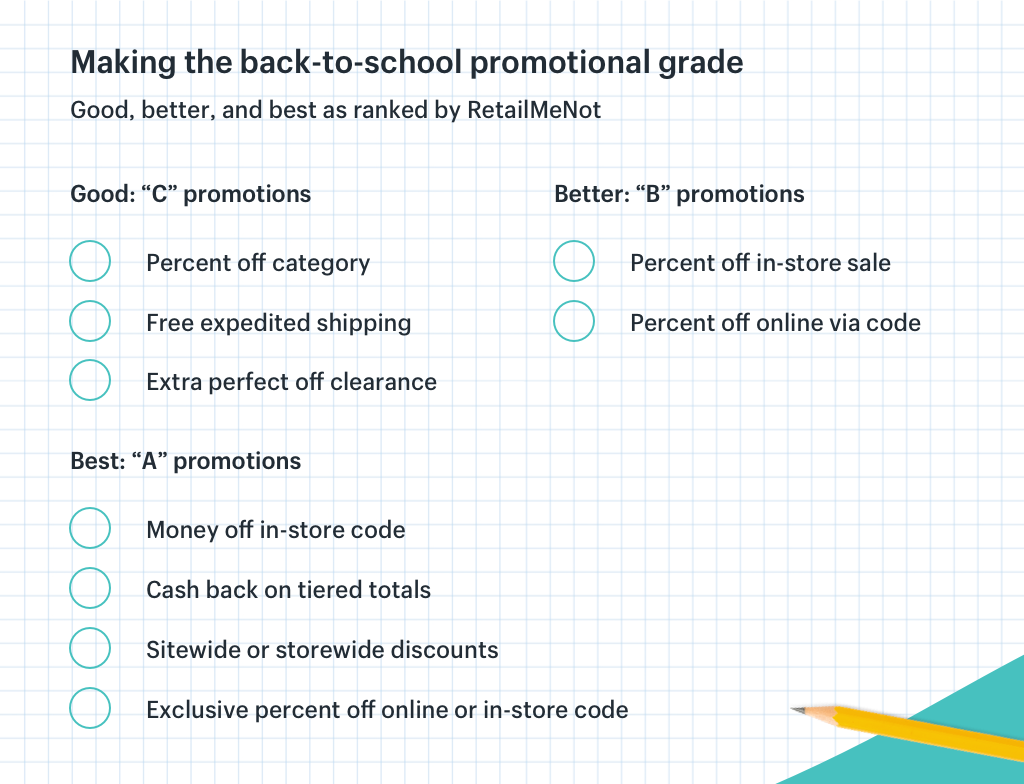
Sitewide discounts being rated “best,” compared to percent-off discount codes being rated “better,” is a strong reason to use something like Launchpad and Shopify Scripts. When operated in tandem, you can change sitewide pricing displays and automate discounts rather than forcing customers to input them at the checkout.
Last year, Deloitte’s survey revealed that 27% of B2S shoppers planned to use social media to find those promotions and coupons.
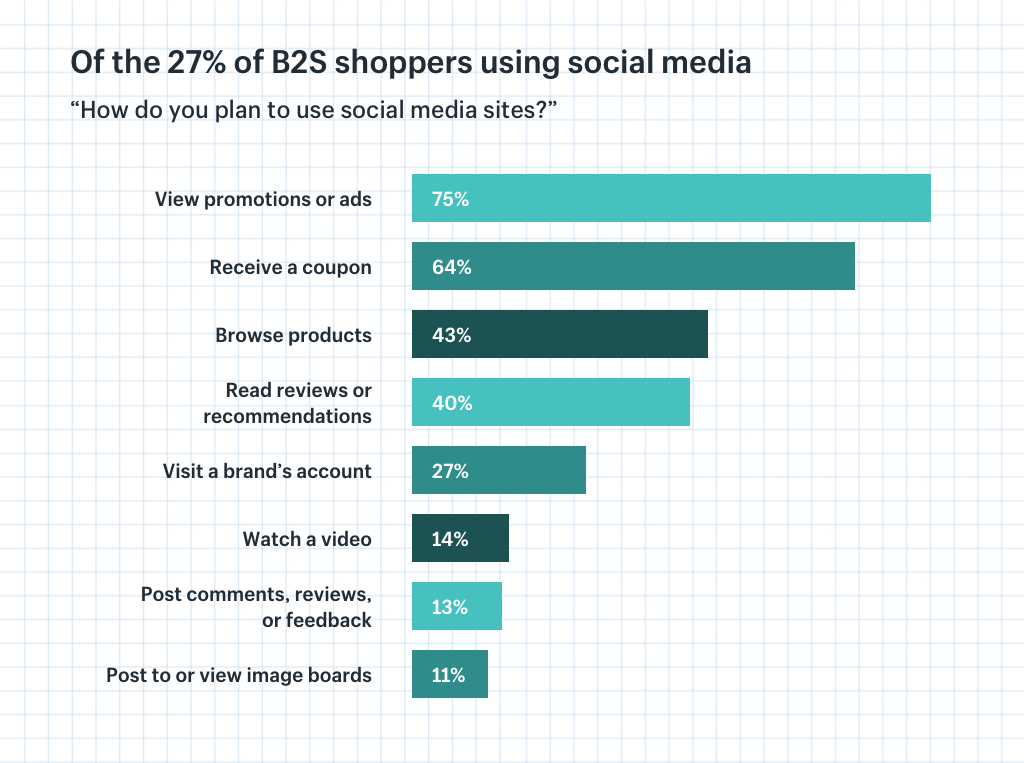
With “72% of retailers planning to increase their investment in social media” (primarily on Instagram and Facebook) in 2018, RetailMeNot suggests to use these supporting channels to attract B2S shoppers:
- Targeted & themed emails
- Targeted exclusive pushes via mobile
- Facebook Live events
- Seasonal blog posts
- Broadcast & satellite media tours
- Digital video and radio ads
Make Amazon Prime Day Your Frenemy
There are many reasons to fear the beast that is Amazon, among them sellers listed:
- Taking away my seller privileges: 61%
- Amazon selling my items: 44%
- Negative customer feedback: 43%

But those same fears are exactly why you should consider building a relationship with Amazon and tapping into its customer base. Think of Amazon Prime Day exposure like buying a Super Bowl ad.
When planning your Amazon Prime Day promotional strategy, here are a few tips to consider …
1. Create a “Symbiotic” Relationship with Amazon
While it’s easy to see Amazon as your competitor; the ecommerce behemoth can also be a valuable sales channel to expose new customers to your brand and drive new revenue growth as per the chart below.

The best way to make the relationship work for you, and avoid cannibalizing your own site, is to sell your “staples” on Amazon, but keep your exclusive promotions and new product releases onsite.
2. Leverage the Full Capabilities of Amazon
Amazon offers vendors many tools to stand out from the millions of products sold to its millions of customers. Amazon Advertising provides merchants with a multi-platform experience, and features like:
- Amazon Search for product searches
- Amazon Ad Platform for static and video assets
- Amazon Media Group for higher-end managed services
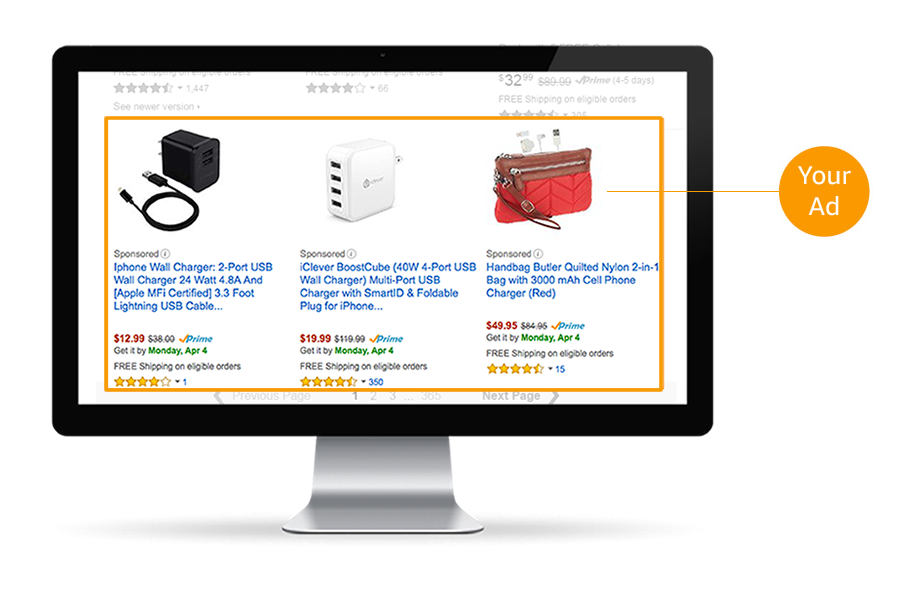
You can use Amazon’s in-house advertising services to ensure your products are featured when customers are researching and shopping. Make sure this is built-into your overall B2S advertising budget.
If you are going to sell via Amazon, you must provide a seamless brand experience across all of your sales channels and a consistent fulfillment process for all orders — wherever they came from.
As Lee Elliott, vice president of digital media at VaynerMedia, explains:
“Sales and marketing on eBay and Amazon are not enough. You have to be able to keep up with the orders from an operations and fulfillment standpoint. You also need to give your customers the same brand experience no matter where they’re shopping.”
Are you currently able to handle the significant increase in sales volume that will come from Amazon Prime Day and B2S promotions without sacrificing your customer service? If not, then consider using Fulfillment by Amazon (FAB).
Keeping all of the promotional insights above in mind, let’s dive into how Shopify business, Dormify, has been automating successful back to school marketing campaigns.
No More All-Nighters: Ecommerce Automation
All-nighters in college or at university are par for the course. They also used to be requirements for seasonal ecommerce sales or new product releases.
For Dormify, this required ecommerce team members to make storefront and back-office updates in real-time, pulling them away for more valuable tasks like optimization and customer care.
“We used to manually change the hero image [for a sales event] by going into the module, basically switching to the HTML viewer, finding the link of the image and then pasting in a new one when we wanted it to go live. We couldn’t do anything in advance,” says Lauren Ulmer, Director of Product at Dormify.
Not anymore …

How Launchpad is Saving Dormify Time & Stress
Dormify’s first use of Launchpad — a free automation tool for Shopify merchants that makes it easy to schedule and monitor major events — was Black Friday Cyber Monday 2017. The team was able to rest easy and offload manual efforts of setting everything up the day of the sale by scheduling all of the site’s creative, copy, and theme changes ahead of time.
As a result, they used the time saved to focus on their campaign strategy.

“We were able to take an hour chunk out of one day and just get it done in advance, schedule it and everyone can go home and sleep well at night,” says Ulmer.
With back to school shopping season just around the corner, the Dormify team is already working on transitioning sale features to the theme settings in Shopify. One of those features is a “Your Price” widget which displays the customer’s discount price on the product page and a coupon code that they can use at checkout.

“When we’re running a sitewide sale, we turn on the ‘Theme Switching’ feature with Launchpad so that we can create dedicated sales themes that reflect promotional messaging,” explains Ulmer.
The ‘Your Price’ Shopify Script that we used, along with Launchpad for our July 4th sale this year, achieved a 70% uplift in conversion rates.
Tracking Sales in Real-Time
The Dormify team is also now able to track its Launchpad-scheduled sales events via a live dashboard like the one in the screenshot below.

This feature helps them to see how a seasonal promotion is performing in real-time, and learn from current consumer behaviors on the site to iterate for the next event.
“I can compare our Memorial Day sale this year versus Memorial Day last year, and get a very nice snapshot in time from running the Launchpad event, which is a great benefit while we’re tracking the live report,” says Ulmer.
Increasing Conversions & Sales Activity
Since the Dormify team began using Launchpad 8 months ago …
We’ve run over 100 sales events using automation and are on track to 2X revenue in 2018 as we become a true omni-channel brand.
The team pre-schedules three stages per promotion:
- Launching
- Ending
- Extending
So, how does Launchpad work?
Here’s a quick video illustrating how Plus brands have used Launchpad to sell more than $3 billion on autopilot and exactly how to schedule a campaign …
Not on Shopify yet? Learn more about ecommerce automation.
Extra Credit: Automating Checkouts and Workflows
Adding extra customizations with Shopify Scripts and streamlining back-end processes with Shopify Flow will also help your team work smarter, rather than harder to drive results.
Improving Your Customer Experience with Scripts
Dormify has had a lot of success with integrating Shopify Scripts into Launchpad-run sales events. Here are a few examples that the company tested over the 2017 holiday shopping season and this past Valentine’s Day:
(1) Unlocking Surprise Discounts
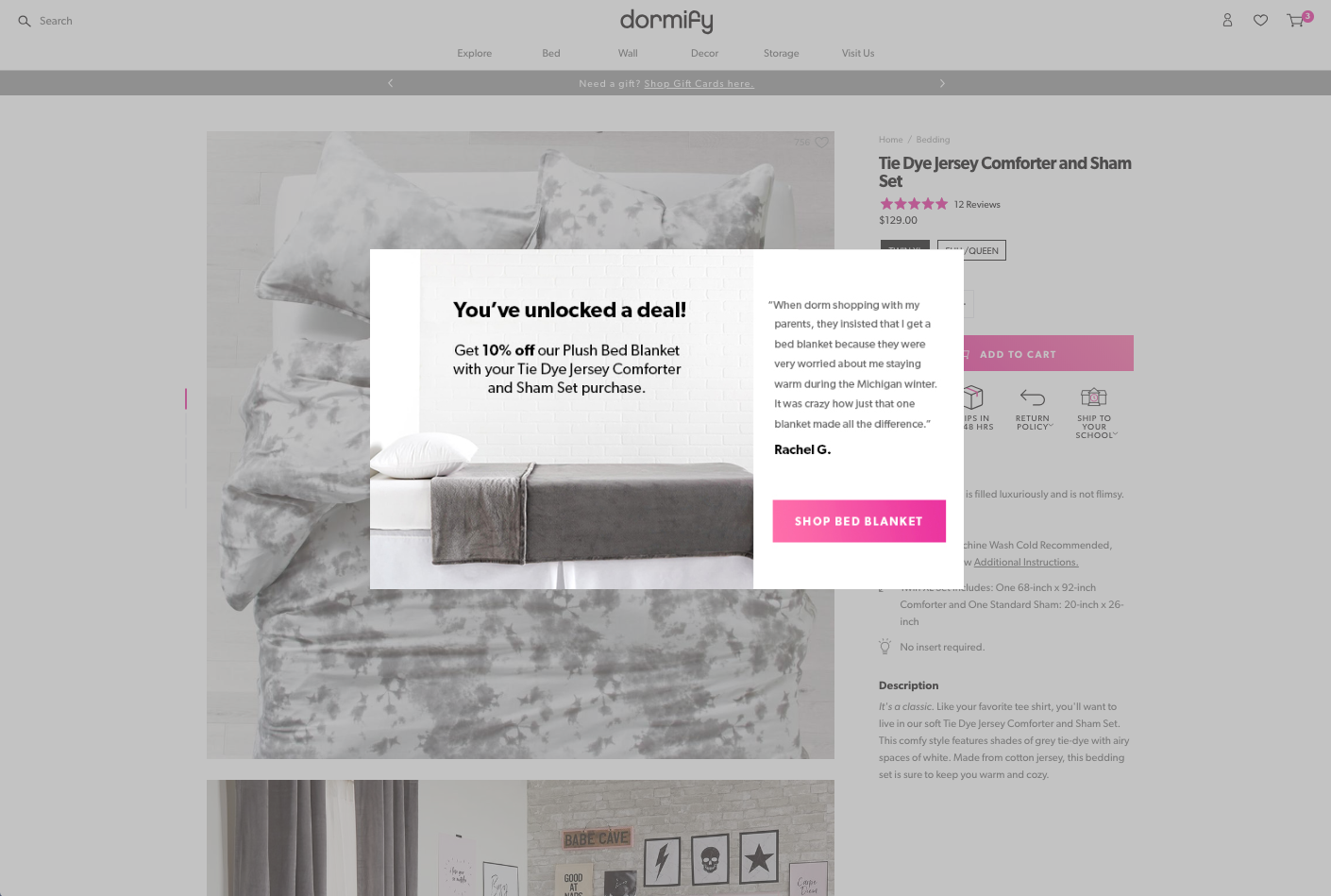
During a recent sales event, Dormify surprised its customers with a special discount whenever they added a particular product, like upselling to add a blanket whenever you add a Duvet Cover or Comforter to your cart.
By surprising and treating customers with a discount, Dormify doubled sales of the product within two weeks of having the modal active.
(2) Setting Delivery Date Expectations
To incentivize higher average order value, Dormify automates free shipping notifications at the cart level (as well as personalized recommendations):

But, as you get closer to events like B2S or the holidays, shipping timelines become critical. During Cyber Monday 2017, Dormify wanted to set shipping expectations up front with customers as they shopped on the site.
The solution was to implement a split cart functionality. Dormify was able to show whether products in a customer’s cart were eligible to ship within a quick time frame. If the products couldn’t arrive in time, they were identified in the cart as shipping separately.

(3) Free Gift Script for In-Store Purchases
To make the online to offline (O2O) shopping experience at all Dormify Style Studio locations feel seamless, the ecommerce team uses a free shipping script, with no minimum threshold on all orders placed on the website in-store. “We wanted to give our customers the benefit that they would typically receive from shopping in any other store location,” says Ulmer.

This test helped Dormify to draw incremental visits to the store and build brand loyalty.
Streamlining Back-End Operations with Shopify Flow
Shopify Flow, an ecommerce automation platform that allows merchants to customize unique backend business workflows and simplify processes, has helped the Dormify team to save time and money by easily capturing low inventory levels, preventing fraudulent orders, and tagging customers based on key attributes to be used for future email campaigns.
Here’s how each of those Shopify Flow workflows are setup...
(1) Low inventory tracking
The Dormify team tracks and maintains inventory levels in a timely manner through a workflow that sends the ecommerce team a Slack Message when quantities reach a certain threshold.
![]()
“This workflow enables us to be proactive and send a message to our buyer as a heads up. For example, if there are only ten items left in stock,” says Ulmer. “We can notify her that inventory is at this amount without having to go through all 3,000 of the products in our catalog to identify which ones to re-order.”
(2) High-Risk of Fraudulent Order Review Notifications
If an order risk level is determined to be “high,” Flow automatically sends a Slack message to the customer service team’s channel, adds a “Fraud” order tag, which cancels the order, and sends a notification to the customer, while simultaneously sending an email to Dormify’s ecommerce team.
If order risk level does NOT equal “high,” then the payment is captured as usual.

(3) Tagging Customers Based on Specific Attributes
To create an evergreen way to build out a list for upcoming email campaigns, Dormify developed a workflow that tags customers based on certain attributes, like ordering Twin bed sheets, so they can target them with bedding promotions at a later date.
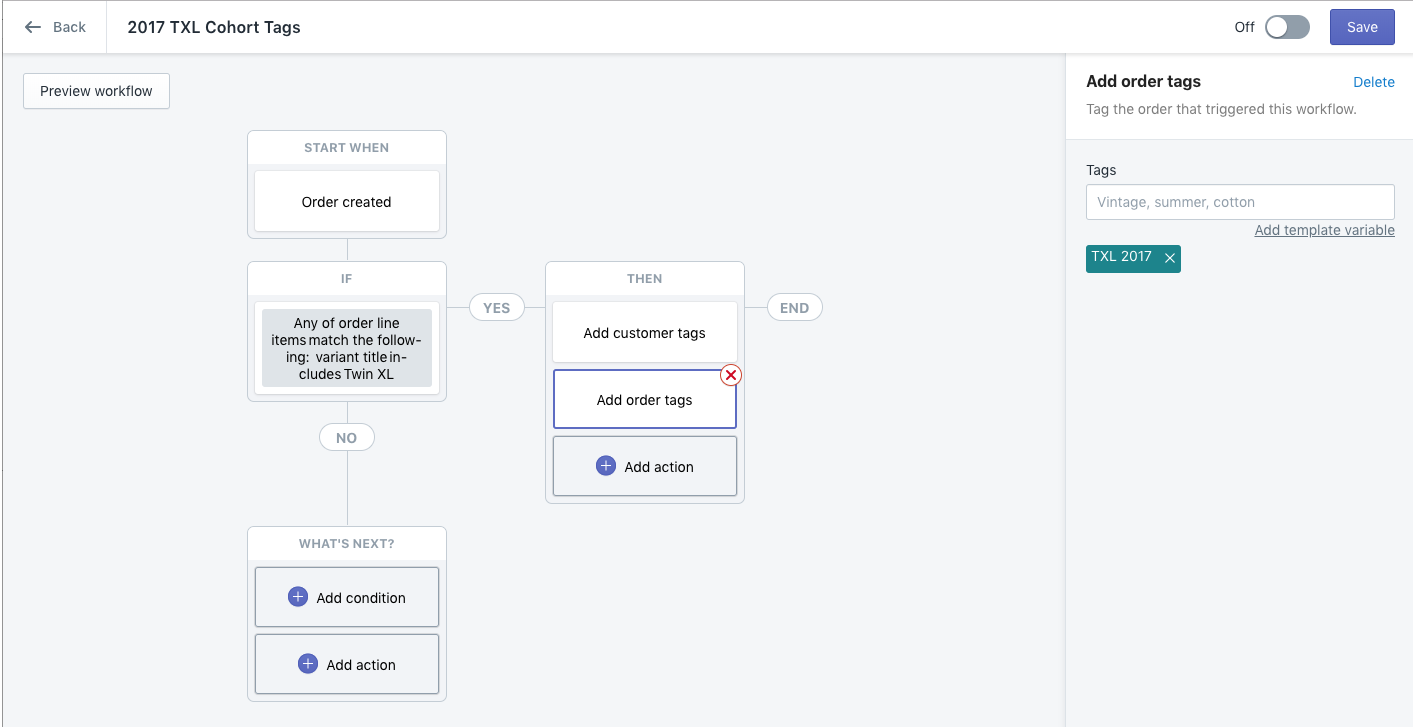
“This saves us a lot of time because we can quickly build an email list that we can export for a campaign that is ready to go,” says Ulmer.
To learn more about other possible Shopify Flow workflows, refer to this post on the Shopify Enterprise blog.
Don’t Miss the Bus on Your Back to School Marketing Campaigns
It’s likely that you’ve already planned your B2S promotions for the 2018 online shopping season. But there is still time to automate the execution of your sales events to save your team time while maximizing conversions.
With Launchpad, you can focus on building your merchandising, pricing, and messaging, not the manual efforts on your pre-sale checklist.
Just schedule the sale in Launchpad with a start and end date. Set discounts, release products, and schedule theme changes to highlight your event with no coding required.
By integrating Shopify Scripts into a scheduled theme in Launchpad, you can take your customer experience to the next level and increase sales. And with Shopify Flow, you can decrease your B2S shopping season stress even further by creating custom workflows to streamline your back-end sales operations.
Not on Shopify yet? Learn more about ecommerce automation.
Read more
- The 1 Rule for Building a Billion-Dollar Business
- The Death of Advertising as We Know It
- 3 DTC Brands on How They Build Customer Loyalty
- Back-to-School Ecommerce: Infographic & Lessons from $58.1B in Online Sales
- How I Raised $1.1 Million Without a Network or Experience
- Conversion Rate Optimization: What Everyone Gets Wrong and How to Do It Right
- Reimagining Racial Equity in the Fashion Industry
- Top Omnichannel Logistics and Supply Chain Challenges in Ecommerce
- Multichannel Inventory Management: Problems & Solutions



